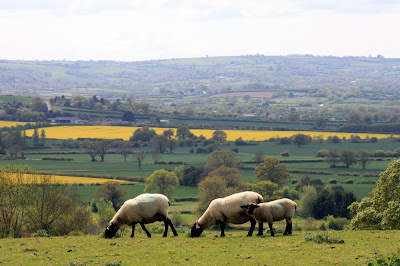This weekend saw an earnest quest for bluebells in Gloucestershire. However this was no random sortie...but a perfectly timed military manoeuvre with destination, sturdy footwear, camera gear and refreshments carefully thought out (well the last one was a quick dip into the local CO-OP). The destination was Lower Woods, near Westonbirt, which is a local wildlife trust reserve...and what a place it is.
There are a number of walks which take you on a circular route. Ours started by entering a fine unimproved meadow, which supports a great array of interesting plants. At the moment the two of note are the dainty cuckoo flower (or lady's mantle) and an unusual fern called Adder's Tongue. The fern is especially picky and can only be found on grassland that is not only very old, but also has not been fertilised and has been traditionally managed.
Flower rich meadow
Cuckoo flower
Adder's tongue fern
The fern is only a couple of inches high, at most, and consists of a single leaf ("frond") - weird eh?
So what about the woodland then...
The woodlands are not only exciting for their bluebells, but as they are ancient woodlands also play host to a myriad of other woodland species. My previous blogs show images of some of the flowers that have already been in bloom, but now there are a few more to see.
One spectacular species is the early purple orchid, which can be found as scattered individuals or small groups, where ever the woodland canopy is open enough.
Other notable plants include the uncommon herb paris and the more common yellow archangel. Where primroses and cowslips are present they combine to form a hybrid called the false oxlip.
Herb paris
Yellow archangel
False oxlip
An old house sits in the middle of the woodland; at one time there must have been a well tended garden. Now only an ancient tree stands, along with a tall pear tree. Next to the house is a large apple tree in full blossom.
Apple blossom
The woodland still provides charcoal from the charcoal burner and bean sticks from suitably straight hazel coppice. Here are some poles cut this winter and not yet sold:
Coppicing is a practice of managing woodland by repeatedly cutting the hazel understory every few (7 -12) years to produce wood for hurdles, charcoals, bean sticks etc.. It lloks drastic but hass been practiced in the majority of English woodlands for centuries - the hazel grows back just as strong. The large trees (the "standards") are selectedly left to grow for about 100+ years then felled for timber and replanted.
Here is what an area of open coppice woodland looks like after it has been actively managed - the ground flora loves this, as do a number of butterlies. Without this practice the woodland becomes dark and the ground flora significantly deminished.
An ancient coppice (ash) stool
All in all a successful mission!
































































